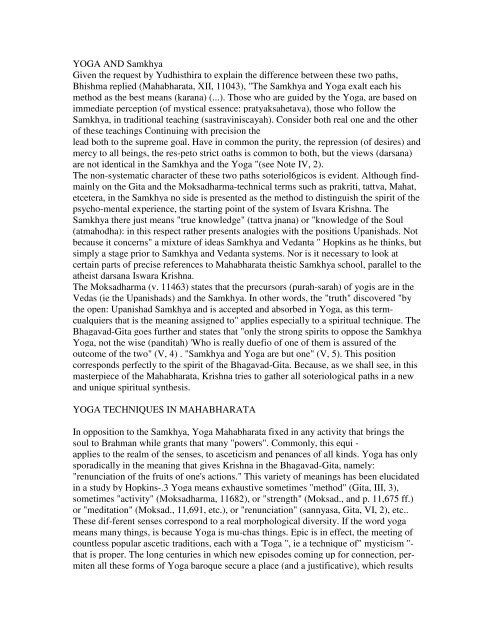Mircea Eliade YOGA IMMORTALITY AND ... - Brihaspati.net
Mircea Eliade YOGA IMMORTALITY AND ... - Brihaspati.net
Mircea Eliade YOGA IMMORTALITY AND ... - Brihaspati.net
Create successful ePaper yourself
Turn your PDF publications into a flip-book with our unique Google optimized e-Paper software.
<strong>YOGA</strong> <strong>AND</strong> Samkhya<br />
Given the request by Yudhisthira to explain the difference between these two paths,<br />
Bhishma replied (Mahabharata, XII, 11043), "The Samkhya and Yoga exalt each his<br />
method as the best means (karana) (...). Those who are guided by the Yoga, are based on<br />
immediate perception (of mystical essence: pratyaksahetava), those who follow the<br />
Samkhya, in traditional teaching (sastraviniscayah). Consider both real one and the other<br />
of these teachings Continuing with precision the<br />
lead both to the supreme goal. Have in common the purity, the repression (of desires) and<br />
mercy to all beings, the res-peto strict oaths is common to both, but the views (darsana)<br />
are not identical in the Samkhya and the Yoga "(see Note IV, 2).<br />
The non-systematic character of these two paths soteriol6gicos is evident. Although findmainly<br />
on the Gita and the Moksadharma-technical terms such as prakriti, tattva, Mahat,<br />
etcetera, in the Samkhya no side is presented as the method to distinguish the spirit of the<br />
psycho-mental experience, the starting point of the system of Isvara Krishna. The<br />
Samkhya there just means "true knowledge" (tattva jnana) or "knowledge of the Soul<br />
(atmahodha): in this respect rather presents analogies with the positions Upanishads. Not<br />
because it concerns" a mixture of ideas Samkhya and Vedanta " Hopkins as he thinks, but<br />
simply a stage prior to Samkhya and Vedanta systems. Nor is it necessary to look at<br />
certain parts of precise references to Mahabharata theistic Samkhya school, parallel to the<br />
atheist darsana Iswara Krishna.<br />
The Moksadharma (v. 11463) states that the precursors (purah-sarah) of yogis are in the<br />
Vedas (ie the Upanishads) and the Samkhya. In other words, the "truth" discovered "by<br />
the open: Upanishad Samkhya and is accepted and absorbed in Yoga, as this termcualquiers<br />
that is the meaning assigned to" applies especially to a spiritual technique. The<br />
Bhagavad-Gita goes further and states that "only the strong spirits to oppose the Samkhya<br />
Yoga, not the wise (panditah) 'Who is really duefio of one of them is assured of the<br />
outcome of the two" (V, 4) . "Samkhya and Yoga are but one" (V, 5). This position<br />
corresponds perfectly to the spirit of the Bhagavad-Gita. Because, as we shall see, in this<br />
masterpiece of the Mahabharata, Krishna tries to gather all soteriological paths in a new<br />
and unique spiritual synthesis.<br />
<strong>YOGA</strong> TECHNIQUES IN MAHABHARATA<br />
In opposition to the Samkhya, Yoga Mahabharata fixed in any activity that brings the<br />
soul to Brahman while grants that many "powers". Commonly, this equi -<br />
applies to the realm of the senses, to asceticism and penances of all kinds. Yoga has only<br />
sporadically in the meaning that gives Krishna in the Bhagavad-Gita, namely:<br />
"renunciation of the fruits of one's actions." This variety of meanings has been elucidated<br />
in a study by Hopkins-.3 Yoga means exhaustive sometimes "method" (Gita, III, 3),<br />
sometimes "activity" (Moksadharma, 11682), or "strength" (Moksad., and p. 11,675 ff.)<br />
or "meditation" (Moksad., 11,691, etc.), or "renunciation" (sannyasa, Gita, VI, 2), etc..<br />
These dif-ferent senses correspond to a real morphological diversity. If the word yoga<br />
means many things, is because Yoga is mu-chas things. Epic is in effect, the meeting of<br />
countless popular ascetic traditions, each with a 'Toga ", ie a technique of" mysticism "-<br />
that is proper. The long centuries in which new episodes coming up for connection, permiten<br />
all these forms of Yoga baroque secure a place (and a justificative), which results







